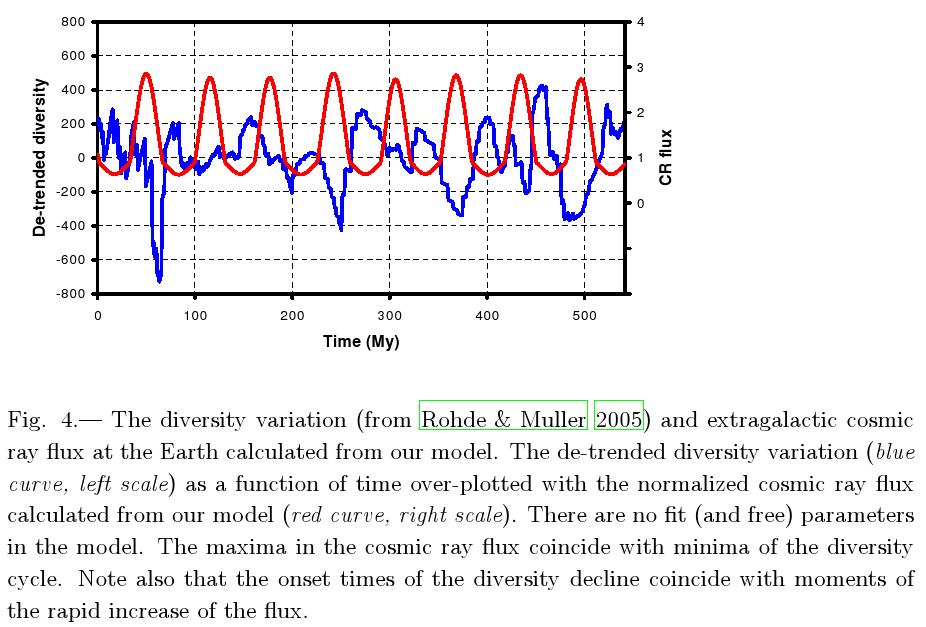
number of technological civilizations in the galaxy =As you can see, computing the number of technological civilizations in the galaxy is largely an exercise in guesswork, Most sources choose values for the various factors so that, in effect, the equation becomesrate of star formation * fraction of those with planets * number of habitable planets *fraction with any life * fraction of those with intelligent life * fraction of those with technology *
lifetime of a technological civilization
number of technological civilizations in the galaxy ~ lifetime of a technological civilizationLet us ask a more tractable question: how many planets are there in the galaxy which harbor any life at all? We will need to take into account the following:
That leaves an annulus (a disc with a circular hole in the center) of inner radius 6 kpc and outer radius 12 kpc, or roughly
π (122 - 62) / (π 152)of the galactic disc which may contain stars with habitable planets. Since the central bulge contains about 30% of the luminous matter in the galaxy, this means that only about 1/3 of the stars in the galaxy may have habitable planets.= 48 %

This indicates that planets lying too far out of the plane of the galactic disc may also receive too much radiation and cosmic ray flux for life to develop. The Sun is currently about 10 pc north of the galactic plane, and moves as far as 70 pc above or below it with time. Assuming that the central half of this variation is compatible with life (70 pc), and that the thickness of the disc is about 150 pc, this reduces our third of eligible stars to about 16%.
So in order for a planet to develop life, it is necessary for liquid water to exist there. We can use the following relationships to estimate the "water zone" around a star of a given mass. From the relation
stellar lifetimeyears = 1010 / masssolar2.5and our last consideration, the star's mass has an upper limit of about 101/2.5 = 2.5 Msolar. Since less than 1% of stars have a mass in excess of 2.5 Msolar, we can safely ignore this limit here.
Because luminosity is approximately equal to mass3.5 (in solar units), the energy flux received by the planet will be
energy flux = luminosity / (4 π distance2)Assuming that the planet has surface water, its temperature must be between the freezing and boiling points of water: 273 and 373 K. Stefan's Law tells us that in equilibrium (another assumption, but reasonable), the energy flux should be equal to the= Msolar3.5 Lsolar / (4 π distance2)
power emitted per unit area = σ * temperature4so the flux received from its star should be between
σ 2734 = 315 W / m2and
σ 3734 = 1097 W / m2Our Earth obviously violates this bound, but we have not taken into account atmospheric effects. Since the average surface temperature of the Earth is 288 K, and we receive about 1365 W / m2 from the Sun, we can estimate that the presence of an atmosphere alters these numbers by the factor
1365 / (σ * 2884) = 3.5to give us 1100 and 3840. Setting our expression above for the energy flux equal to these two values, we find that the orbital distance (semimajor axis length) should be between
(Msolar3.5 Lsolar / (4 π 1100))1/2and= Msolar1.75 * 1.67 * 1011 m = 1.12 AU * Msolar1.75
(Msolar3.5 Lsolar / (4 π 3840))1/2If we consider our Solar System to extend out to the orbit of Neptune, at 30 AU, and assume that is a typical size, this implies that habitable planets would only be found in an annulus representing about= Msolar1.75 * 8.93 * 1010 m = 0.6 AU * Msolar1.75
π (1.122 - 0.62) / (π 302)of the Solar System's volume. Since Earth is one of eight planets in the Solar System, we might reasonably guess that about one in a hundred stars has a habitable planet in orbit. Since there are about 100 billion stars in our galaxy, and we have estimated that 4% of them might be eligible to have a habitable planet, but only 1% of those do, we conclude that in our galaxy alone, there are about 40 million worlds with life of some kind.= 0.1 %
This study indicates that 20% of the stars in our galaxy have habitable planets. If that is true, our analysis is low by a factor of 5.
©2013, Kenneth R. Koehler. All Rights Reserved. This document may be freely reproduced provided that this copyright notice is included.
Please send comments or suggestions to the author.